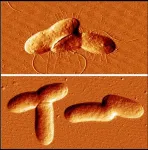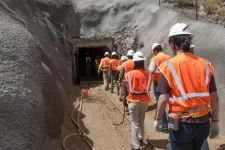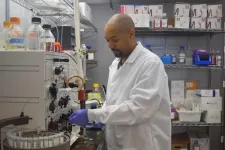(Press-News.org) FOR IMMEDIATE RELEASE
January 10, 2025
Contact:
Jillian McKoy, jpmckoy@bu.edu
Michael Saunders, msaunder@bu.edu
##
Lower Access to Air Conditioning May Increase Need for Emergency Care for Wildfire Smoke Exposure
As Los Angeles County battles the most destructive wildfires in its history, a new study suggest that US policies should prioritize equity and education regarding the measures people can take to protect themselves from the harmful pollutants in wildfire smoke.
People who have limited access to air conditioning may be at higher risk of seeking emergency care for health problems following exposure to wildfire smoke, according to a new study led by Boston University School of Public Health (BUSPH).
Posted online ahead of publication in the journal Environmental Research: Health, the study found that exposure to fine particle matter (PM2.5) from wildfire smoke in California is associated with higher rates of emergency department visits for all causes, non-accidental causes, and respiratory disease. This risk varied by age and race, but was especially high for individuals who lived in areas with lower availability of air conditioning.
The findings come at a critical time, as firefighters in Southern California continue to battle multiple wildfires that have been blazing in and around Los Angeles County since Tuesday, January 7—including the Palisades fire, which is likely the largest and most destructive wildfire in the county’s history. Health experts are urging residents who are not under evacuation orders and can safely remain in their homes to turn on air conditioners and/or air purifiers if they have access to these devices.
Despite this guidance—and the growing threat of more frequent and intense wildfires due to worsening climate change—very little research has examined how the health effects of wildfire smoke exposure may differ based on individuals’ access to air conditioning. Understanding this relationship can inform policies and interventions that mitigate barriers to air conditioners and protect vulnerable populations from the consequences of inhaling PM2.5 and other harmful pollutants from this smoke, which can permeate the air from hundreds or thousands of miles away.
“Depending on the type of system and filter used, air conditioning may modify the impact of smoke exposure on human health,” says study lead and corresponding author Dr. Jennifer Stowell, research scientist in climate and health at BUSPH, noting that the analysis only addressed the likelihood of access to air conditioning, rather than air conditioning types or actual usage. “Studies like these will become more and more relevant as wildfire exposure increases. California is, perhaps, the best example of this in the US, with bigger fires and longer fire seasons. An important next step will be to identify ways to better characterize access to air conditioning.”
For the study, Dr. Stowell and colleagues from BUSPH, Boston University College of Arts & Sciences (CAS), and the Health Effects Institute utilized a nationwide dataset of healthcare claims to assess more than 50,000 emergency department visits during the 2012-2019 California wildfire seasons, which occurred from May to November each year. They quantified the adverse health effects from PM2.5 exposure among all study participants, as well as subgroups of participants.
Consistent with prior research, wildfire smoke exposure was most strongly associated with emergency department visits for respiratory issues, but not cardiovascular-related complications. These visits were generally higher among children under 10 years old, adults between 20-74 years old, and among the Black population, although also elevated among White, Hispanic, and Asian/Pacific Islander populations.
People living in areas with lower availability of air conditioning had a 22-percent greater risk of visiting the emergency department for respiratory conditions associated with wildfire smoke exposure. Greater insight into air conditioning use as a pollutant-filtering tool and the barriers that certain populations face in accessing these cooling systems is critical, as wildfires are expected to occur more regularly in the Wildland-Urban Interface (WUI)—areas where human activity is in close contact with sources of dry fuel. This is exactly what is happening now in LA County, Dr. Stowell says, as the fires destroy thousands of homes and businesses near vegetation.
“WUI fires are particularly concerning due to the burning of manmade structures and the additional toxic chemicals and particulates that can be found in their smoke plume,” says Dr. Stowell. “The current fires in LA are out-of-season fires driven by severe Santa Ana winds coming from the mountains. As climate change continues, the temperature differentials between land and sea will grow and, potentially, drive stronger and stronger late-season or out-of-season wind events.”
So how may residential air conditioners help dispel PM2.5 from homes? The filters in these cooling systems can remove particulate matter, although certain filters are more effective at filtering particulate matter than others. “HEPA filters can remove the majority of particles greater than 0.3 µm, but they are significantly more expensive than fiberglass air filters, which only remove larger particles and may allow high amounts of fine particulate matter to penetrate indoors,” Dr. Stowell says. “Generic pleated air filters are also fairly efficient at filtering out most particulate matter.”
Air conditioning systems with a Minimum Efficiency Reporting Value (MERV) rating of seven or higher are thought to be the most efficient at removing particulate matter from outdoor air, but are also more expensive.
The study findings indicate a need for stronger policy measures that can reduce the health risks associated with wildfire smoke exposure.
"Many homeowners do not understand the differences between MERV ratings and how these might impact your health,” Dr. Stowell says. “Policymakers should consider delivering better information to the public—such as the types and ratings of filters that perform better—especially for those who reside in smoke-prone regions.”
Given that marginalized populations appear to be disproportionately burdened by the health effects of wildfire smoke exposure, economic assistance should also be considered, she says, particularly for low-income populations residing in smoke-prone regions. “Considering the current fires in CA, local and state governments should heighten their responses to these events and develop plans and policies to reduce exposure before the fires occur,” Dr. Stowell says.
The study’s senior author is Dr. Gregory Wellenius, professor of environmental health and director of the Center for Climate and Health at BUSPH. The study was coauthored by Dr. Ian Sue Wing, professor of earth and environment at CAS; Dr. Yasmin Romitti, staff scientist at the Health Effects Institute, and Dr. Patrick Kinney, Beverly Brown Professor of Urban Health at BUSPH.
**
About Boston University School of Public Health
Founded in 1976, Boston University School of Public Health is one of the top ten ranked schools of public health in the world. It offers master's- and doctoral-level education in public health. The faculty in six departments conduct policy-changing public health research around the world, with the mission of improving the health of populations—especially the disadvantaged, underserved, and vulnerable—locally and globally.
END
Lower access to air conditioning may increase need for emergency care for wildfire smoke exposure
As Los Angeles County battles the most destructive wildfires in its history, a new study suggest that US policies should prioritize equity and education regarding the measures people can take to protect themselves from pollutants in wildfire smoke.
2025-01-10
ELSE PRESS RELEASES FROM THIS DATE:
Dangerous bacterial biofilms have a natural enemy
2025-01-10
If your teeth have ever felt fuzzy after skipping a brushing, you’ve encountered biofilm—a slimy bacterial layer that clings to surfaces. In medical settings, biofilms make infections harder to treat when they form protective shields for bacteria on devices like catheters and implants.
UC Riverside scientists have now discovered a chemical that plants produce when they're stressed prevents biofilm from forming. The breakthrough offers potential advances in healthcare as well as preventing equipment corrosion in industrial settings.
“In simple terms, biofilms are communities ...
Food study launched examining bone health of women 60 years and older
2025-01-10
Hinda and Arthur Marcus Institute for Aging Research investigators at Hebrew SeniorLife have launched a large clinical food trial to test whether a combination of probiotics and prebiotics (BondiaÒ or SBD111) developed by Solarea Bio will help manage bone health in women aged 60 years and above. The first participants have joined the study and the Institute seeks additional women for the 18-month effort.
“I am very happy to be involved in this important research to help with bone health in women,” says study participant Kathy ...
CDC awards $1.25M to engineers retooling mine production and safety
2025-01-10
From mapping ore to predicting slope behavior and reclaiming land, mining is a rapidly evolving technological industry. Yet planning and operations have not necessarily kept up with the advancements.
With $1.25 million from the National Institute for Occupational Safety and Health, or NIOSH, mining and geological engineering researchers in the University of Arizona College of Engineering are boosting their efforts to better align technology and planning for improved safety and productivity.
The award from the institute, part of the Centers for Disease Control and Prevention, will fund the research ...
Using AI to uncover hospital patients’ long COVID care needs
2025-01-10
PHILADELPHIA— Across the United States, no hospital is the same. Equipment, staffing, technical capabilities, and patient populations can all differ. So, while the profiles developed for people with common conditions may seem universal, the reality is that there are nuances that require individual attention, both in the make-up of the patients being seen and the situations of the hospitals providing their care.
New research shows that artificial intelligence can potentially help improve care overall by combing through ...
$1.9M NIH grant will allow researchers to explore how copper kills bacteria
2025-01-10
TUCSON, Arizona — A researcher at the University of Arizona College of Medicine – Tucson received a $1.9 million grant from the National Institutes of Health to continue his research into uncovering the mysteries of copper – specifically, how it can be harnessed to kill harmful bacteria and other microorganisms.
“We started using copper tens of thousands of years ago to cut down on bacterial infections,” said Michael D.L. Johnson, PhD, an associate professor ...
New fossil discovery sheds light on the early evolution of animal nervous systems
2025-01-10
Embargoed until Friday 10-Jan-2025 14:00 ET (10-Jan-2025 19:00 GMT/UTC)
An international team of scientists has uncovered a fascinating piece of the evolutionary puzzle: how the ventral nerve cord, a key component of the central nervous system, evolved in ecdysozoan animals, a group that includes insects, nematodes, and priapulid worms. Their findings, published in Science Advances, provide valuable insights into the origins of these structures in the basal Cambrian period.
The research team, comprising Dr Deng Wang (Northwest University), Dr Jean Vannier (Université ...
A battle of rafts: How molecular dynamics in CAR T cells explain their cancer-killing behavior
2025-01-10
HOUSTON – (Jan. 10, 2025) – A study published in Science Advances shares new insights into how two of the most common types of chimeric antigen receptor (CAR) T cells kill cancer. Investigators from Baylor College of Medicine, Texas Children’s Cancer Center and the Center for Cell and Gene Therapy at Baylor, Houston Methodist Hospital and Texas Children’s Hospital examined how molecular dynamics at the immune synapse – where CAR T cells bind to cancer cells – affect anticancer activity.
In this study, researchers aimed to understand how CAR T cells with different signaling domains work at the molecular and cellular levels to lay the ...
Study shows how plant roots access deeper soils in search of water
2025-01-10
Scientists have discovered how plants adapt their root systems in drought conditions to grow steeper into the soil to access deeper water reserves.
Plant scientists from the University of Nottingham, in collaboration with Shanghai Jiao Tong University, have identified how abscisic acid (ABA), a plant hormone known for its role in drought response, influences root growth angles in cereal crops such as rice and maize. The results have been published in Current Biology.
The study highlights how ABA and auxin, another key hormone, work together to shape root growth ...
Study reveals cost differences between Medicare Advantage and traditional Medicare patients in cancer drugs
2025-01-10
A new study examining the use of high-cost drugs among patients with colorectal cancer and non-small cell lung cancer found those insured through Medicare Advantage received less expensive cancer drugs compared to others on Traditional Medicare.
The findings were published today in JAMA Health Forum.
"Lung cancer is the leading cause of cancer-related deaths in the United States and colorectal cancer ranks third. Gaining a better understanding of treatment options and their costs under different insurance plans is important for assessing the overall healthcare landscape and how insurances manage patient costs,” said the study’s first author Cathy Bradley, PhD, Dean ...
‘What is that?’ UCalgary scientists explain white patch that appears near northern lights
2025-01-10
A whitish, grey patch that sometimes appears in the night sky alongside the northern lights has been explained for the first time by researchers at the University of Calgary.
The article, which was published on Dec. 30 in the journal Nature Communications, explores a “structured continuum emission” that’s associated with aurora borealis.
“You’d see this dynamic green aurora, you’d see some of the red aurora in the background and, all of a sudden, you’d see this structured – almost like a patch – grey-toned or white toned-emission connected to the aurora,” says Dr. Emma Spanswick, ...
LAST 30 PRESS RELEASES:
Making lighter work of calculating fluid and heat flow
Normalizing blood sugar can halve heart attack risk
Lowering blood sugar cuts heart attack risk in people with prediabetes
Study links genetic variants to risk of blinding eye disease in premature infants
Non-opioid ‘pain sponge’ therapy halts cartilage degeneration and relieves chronic pain
AI can pick up cultural values by mimicking how kids learn
China’s ecological redlines offer fast track to 30 x 30 global conservation goal
Invisible indoor threats: emerging household contaminants and their growing risks to human health
Adding antibody treatment to chemo boosts outcomes for children with rare cancer
Germline pathogenic variants among women without a history of breast cancer
Tanning beds triple melanoma risk, potentially causing broad DNA damage
Unique bond identified as key to viral infection speed
Indoor tanning makes youthful skin much older on a genetic level
Mouse model sheds new light on the causes and potential solutions to human GI problems linked to muscular dystrophy
The Journal of Nuclear Medicine ahead-of-print tip sheet: December 12, 2025
Smarter tools for peering into the microscopic world
Applications open for funding to conduct research in the Kinsey Institute archives
Global measure underestimates the severity of food insecurity
Child survivors of critical illness are missing out on timely follow up care
Risk-based vs annual breast cancer screening / the WISDOM randomized clinical trial
University of Toronto launches Electric Vehicle Innovation Ontario to accelerate advanced EV technologies and build Canada’s innovation advantage
Early relapse predicts poor outcomes in aggressive blood cancer
American College of Lifestyle Medicine applauds two CMS models aligned with lifestyle medicine practice and reimbursement
Clinical trial finds cannabis use not a barrier to quitting nicotine vaping
Supplemental nutrition assistance program policies and food insecurity
Switching immune cells to “night mode” could limit damage after a heart attack, study suggests
URI-based Global RIghts Project report spotlights continued troubling trends in worldwide inhumane treatment
Neutrophils are less aggressive at night, explaining why nighttime heart attacks cause less damage than daytime events
Menopausal hormone therapy may not pose breast cancer risk for women with BRCA mutations
Mobile health tool may improve quality of life for adolescent and young adult breast cancer survivors
[Press-News.org] Lower access to air conditioning may increase need for emergency care for wildfire smoke exposureAs Los Angeles County battles the most destructive wildfires in its history, a new study suggest that US policies should prioritize equity and education regarding the measures people can take to protect themselves from pollutants in wildfire smoke.




